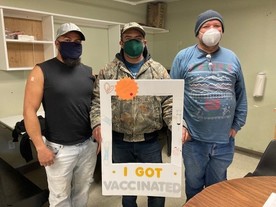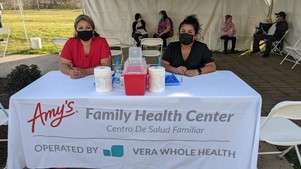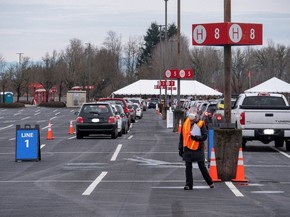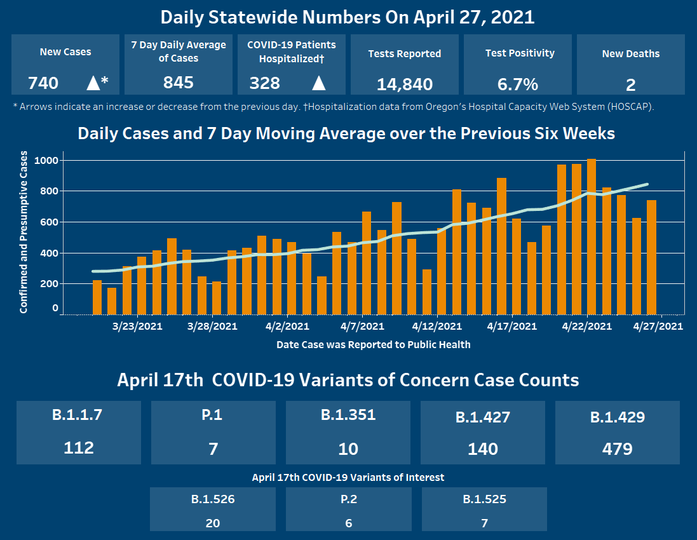 |
April 27, 2021
Some folks can go to work, get vaccinated
Now that everyone 16 and older is eligible to get the COVID-19 vaccine, some employers are rolling up their sleeves and offering vaccinations at work.
In Hood River, One Community Health is participating in a pilot program with Federally Qualified Health Centers (FQHC) to vaccinate communities that COVID-19 is disproportionately impacting.
 The need to reach folks who work in agriculture, especially those who migrate during the harvest season presented an opportunity to work with Duckwall Fruit, a local orchardist. Duckwall Fruit made their warehouse space available to vaccinate their employees, local growers and other migrant seasonal farmworkers (MSFW). Pictured at left, workers in Hood River after getting vaccinated. The need to reach folks who work in agriculture, especially those who migrate during the harvest season presented an opportunity to work with Duckwall Fruit, a local orchardist. Duckwall Fruit made their warehouse space available to vaccinate their employees, local growers and other migrant seasonal farmworkers (MSFW). Pictured at left, workers in Hood River after getting vaccinated.
Josefina Luna, an operations analyst for One Community Health, said, “As of April 5, we have vaccinated more than 3,800 people, nearly half of them identified as Hispanic/Latino and two-thirds of those identified as MSFWs. One Community Health will continue working with local packing houses and growers to vaccinate vaccinate incoming migrant farm workers as the harvest season approaches.” Another business offering workplace vaccinations is Amy’s Kitchen near Medford. Amy’s Kitchen is a California-based maker of organic prepared foods and employs about 900 people in Jackson County. The company teamed up with Vera Whole Health to set up a vaccine clinic at the company’s onsite health center, pictured below. |

Because employees had lots of questions, Plant Manager George Pelch said the company is doing all it can to share vaccine facts. An information board and fact sheets were set up and distributed in the plant. Pelch said, “We hope as many people as possible will get vaccinated. We are also opening up vaccine appointments to employees and their families because our workers and their families are part of the Amy’s Kitchen family and we want them all to be safe.” Folks in the Portland Metro Area can visit the mass vaccination clinic at the Portland International Airport’s Red Economy Parking Lot to get their shots. |
 The PDX site, at left, came together following a conversation between executives from The Port of Portland and Oregon Health & Sciences University and was initially open to people most at risk of getting COVID-19, like older adults and people with underlying health conditions. Now that everyone 16 and older is eligible to get a COVID-19 vaccine, anyone with an appointment can get their shot at this drive-through clinic. Port of Portland spokesperson Kama Simonds said, “We have appreciated the partnership with OHSU for such an important community benefit. And, it couldn’t be more convenient for people who work at PDX to be able to receive their vaccine so close to where they work.” The PDX site, at left, came together following a conversation between executives from The Port of Portland and Oregon Health & Sciences University and was initially open to people most at risk of getting COVID-19, like older adults and people with underlying health conditions. Now that everyone 16 and older is eligible to get a COVID-19 vaccine, anyone with an appointment can get their shot at this drive-through clinic. Port of Portland spokesperson Kama Simonds said, “We have appreciated the partnership with OHSU for such an important community benefit. And, it couldn’t be more convenient for people who work at PDX to be able to receive their vaccine so close to where they work.”
Check with your employer to see if they can offer an onsite vaccine clinic. Employers can use this toolkit as a guide to help their employees get vaccinations. Not all employers will be able to offer this service. Oregon Health Authority (OHA) encourages you to create an account at Get Vaccinated Oregon, or check OHA’s How to Find a COVID Vaccine to learn where you can get vaccinated. |
COVID-19 vaccine breakthrough cases: What are they?
You may be wondering what a breakthrough case is. A breakthrough case is an instance when a person tests positive for COVID-19 at least 14 days after receiving the final dose of a COVID-19 vaccine series. While breakthrough cases are rare, they are expected to occur with any vaccine because no vaccine is 100% effective.
The COVID-19 vaccines that have received Emergency Use Authorizations (EUA) from the U.S. Food and Drug Administration (FDA) have all proven to be highly effective at preventing COVID-19 and that remains true despite the small number of vaccine breakthrough cases that have occurred.
Clinical trials revealed that the Pfizer vaccine was 95% efficacious in preventing COVID-19, while the Moderna vaccine was 94.1% effective and the Johnson & Johnson vaccine was 66.3% effective.
Importantly, breakthrough cases can be prevented through basic public health interventions, such as masking, physical distancing and avoiding social gatherings. These protective measures remain essential as long as there is significant COVID-19 circulating in our communities.
COVID-19 vaccines remain a safe and effective way to prevent yourself from getting infected with COVID-19 and returning to doing the things that you love.
You can learn more about breakthrough cases and how the Centers for Disease Control and Prevention (CDC) is working with state and local epidemiologists to track and investigate them on the Oregon Vaccine News blog.
For more information on the COVID-19 vaccine, visit our webpage at https://covidvaccine.oregon.gov/.
OHA clears health care providers to resume Johnson & Johnson vaccinations
Oregon health care providers and pharmacies may resume administering the Johnson & Johnson COVID-19 vaccine if they can ensure patients or their caregivers are informed about the benefits and risks of the vaccine in their primary language according to Oregon Health Authority (OHA).
On April 13, the federal Centers for Disease Control and Prevention (CDC) recommended a pause on use of the Johnson & Johnson vaccine following reports of rare and serious blood clots in a small number of people, out of the approximately 7.5 million people who’d been vaccinated at the time.
On Friday, April 23, the Food and Drug Administration lifted the pause, with a warning about the potential for rare blood clots for women under age 50.
The Western States Scientific Safety Review Workgroup met on Saturday, April 24, and determined that the Johnson & Johnson vaccine is “generally safe and effective” and use could resume as long as there is information available for patients to make informed decisions. Information about the vaccine needs to be culturally appropriate and easy to understand, in the patient’s primary language.
According to OHA’s guidance to health care providers, “Recipients of the Johnson & Johnson vaccine should be made aware of this rare potential risk of blood clots within the first three weeks of vaccination.”
Updated fact sheets including this warning have been approved by the FDA, including the Fact Sheet for Healthcare Providers administering vaccine and the Fact Sheet for Recipients and Caregivers. These fact sheets also include information on when to seek medical attention.
You can read more about this decision in the news release.
People in Oregon urged to get vaccinated as 15 counties qualify for Extreme Risk
Due to the rapid spread of COVID-19 in Oregon, Governor Kate Brown today announced updates to county risk levels under the state’s public health framework. With hospitalizations rising above 300 people statewide, threatening to overwhelm doctors and nurses, 15 counties will move to the Extreme Risk level effective Friday, April 30 through Thursday, May 6. In addition, nine counties will be in the High Risk level, four at Moderate Risk, and eight at Lower Risk. A complete list of counties and their risk levels is available here.
In an effort to speed up the return to normal business operations, county COVID-19 data will be evaluated weekly for at least the next three weeks. Any updates to county risk levels next week will be announced on Tuesday, May 4 and take effect on Friday, May 7. Counties that improve their COVID-19 metrics will have the opportunity to move to a lower risk level. Counties will remain in Extreme Risk for a maximum of three weeks.
Under the Risk Level framework, counties move to (or remain in) Extreme Risk when they meet the county metrics for case rates and percent positivity, and Oregon meets statewide hospitalization metrics: COVID-19 positive patients occupying 300 hospital beds or more, and a 15% increase in the seven-day hospitalization average over the past week.
The full press release includes information on efforts to aid businesses and other details. You can read it here.
Outdoor capacity limits raised for Extreme Risk counties
Outdoor capacity limits for bars, restaurants, and other sectors will be raised from 50 to 100 people in Extreme Risk counties, with health and safety measures, including physical distancing, in place.
Governor Brown said, “We know that the risk of COVID-19 transmission is lower outdoors. I am urging all Oregonians, if you choose to gather with others, keep it outdoors. Indoor transmission is a key driver in the COVID-19 surge that is making renewed health and safety restrictions necessary.”
The Oregon Health Authority is also working to align Oregon’s outdoor mask guidance with the CDC guidance announced today.
Oregon reports 740 new confirmed and presumptive COVID-19 cases, 2 new deaths
There are two new COVID-19 related deaths in Oregon, raising the state’s death toll to 2,488, the Oregon Health Authority reported at 12:01 a.m. today.
Oregon Health Authority reported 740 new confirmed and presumptive cases of COVID-19 as of 12:01 a.m. today, bringing the state total to 182,040.
Vaccinations in Oregon
Today, OHA reported that 28,212 new doses of COVID-19 vaccinations were added to the state immunization registry. Of this total, 16,907 doses were administered on April 26 and 11,305 were administered on previous days but were entered into the vaccine registry on April 26. Cumulative daily totals can take several days to finalize.
The seven-day running average is now 34,529 doses per day.
Oregon has now administered a total of 1,516,928 first and second doses of Pfizer, 1,243,461 first and second doses of Moderna and 92,725 single doses of Johnson & Johnson COVID-19 vaccines. As of today, 1,188,803 people have completed a COVID-19 vaccine series. There are 1,753,789 who have had at least one dose.
To date, 1,819,935 doses of Pfizer, 1,538,800 doses of Moderna and 215,000 doses of Johnson & Johnson COVID-19 vaccines have been delivered to sites across Oregon.
These data are preliminary and subject to change.
OHA’s dashboards provide regularly updated vaccination data, and Oregon’s dashboard has been updated today.
Cases and deaths
The new confirmed and presumptive COVID-19 cases reported today are in the following counties: Baker (5), Benton (16), Clackamas (64), Clatsop (8), Columbia (10), Coos (6), Crook (9), Curry (4), Deschutes (80), Douglas (15), Grant (7), Harney (5), Hood River (1), Jackson (29), Jefferson (3), Josephine (8), Klamath (45), Lake (4), Lane (67), Lincoln (3), Linn (23), Malheur (8), Marion (48), Multnomah (116), Polk (8), Tillamook (2), Umatilla (15), Wallowa (2), Wasco (4), Washington (114) and Yamhill (11).
Oregon’s 2,487th COVID-19 death is an 88-year-old woman from Harney County who tested positive on Feb. 8 and died on March 21 at her residence. She had underlying conditions.
Oregon’s 2,488th COVID-19 death is an 86-year-old woman from Clackamas County who tested positive on April 22 and died on April 26 at her residence. She had underlying conditions.
COVID-19 hospitalizations
The number of hospitalized patients with COVID-19 across Oregon is 328, which is nine more than yesterday. There are 71 COVID-19 patients in intensive care unit (ICU) beds, which is six less than yesterday.
The total number of COVID-19 positive patient bed-days in the most recent seven days is 2,064, which is a 37% increase from the previous seven days. The peak daily number of beds occupied by COVID-19 positive patients in the most recent seven days is 328.
The total number of patients in hospital beds may fluctuate between report times. The numbers do not reflect admissions per day, nor the length of hospital stay. Staffing limitations are not captured in this data and may further limit bed capacity.



